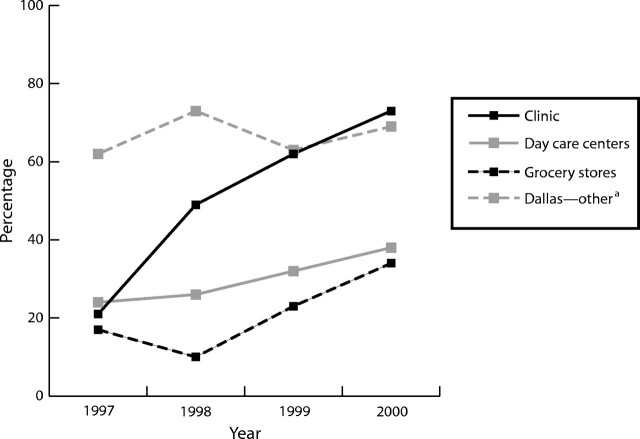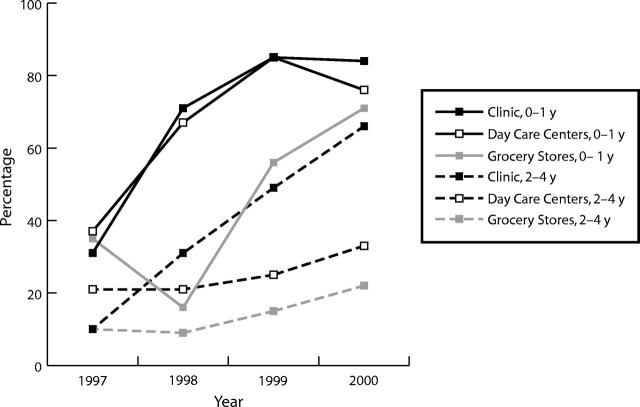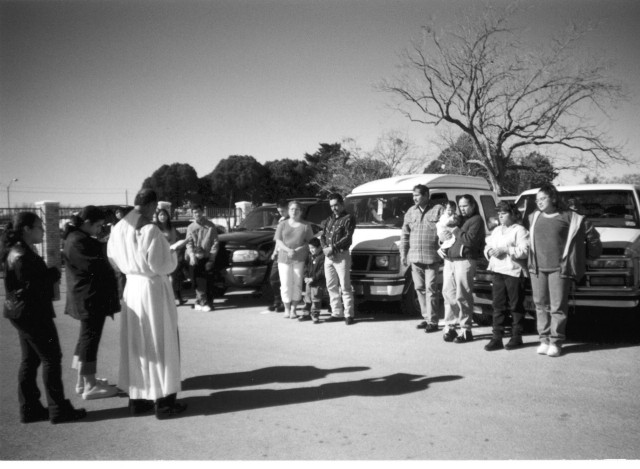Abstract
The use of restraints in motor vehicles is less common in minority and low-income populations than in the general population. A preliminary survey of Hispanic preschool-aged children in west Dallas, Tex, conducted in 1997 showed much lower child restraint use (19% of those surveyed) than among preschool children of all races in the rest of the city (62%).
Because there are few reports of successful programs to increase child restraint use among Hispanics, we undertook to implement and evaluate such a program. The program was conducted by bilingual staff and was tailored for this community. It was successful in increasing both child restraint use and driver seat belt use.
MINORITY AND LOW-INCOME populations are less likely than the general population to use restraints in motor vehicles.1–4 A preliminary survey of Hispanic preschool-aged children in west Dallas, Tex, conducted in 1997 showed that the percentage using child restraints was much lower in this population (19%) than among preschool children of all races in the rest of the city (62%).5
Information obtained from focus groups of Hispanic parents in the community led to development of a program tailored to that population. Activities were carried out at neighborhood parties and in a local community health center, local day care centers, churches, community centers, and botanicas (stores that sell traditional Hispanic remedies and often employ a folk healer). Child safety seats were distributed through parent education classes in a variety of locations.
Child motor vehicle restraint use was evaluated through structured observational surveys, which showed a significant increase in child restraint use in the community. By 2000, restraint use among Hispanic preschool-aged children attending the clinic (72%) had surpassed use in a comparison population of preschool-aged children in the rest of Dallas (69%).
THE PROGRAM
Three adjacent zip codes (75208, 75211, and 75212) in the west sector of Dallas were chosen for the survey because of their predominantly Hispanic population (population 110 000, 60% Hispanic). Preliminary surveys had shown that child restraint use among Hispanic preschool-aged children was lower than 20% in several settings in these zip codes.
We used the Safe Communities model to develop community interventions.6 Components of the program are listed in Table 1▶. The interventions were developed from standardized educational programs, with modifications based on information obtained from 6 focus groups in the Hispanic community. These included establishing a child safety seat loaner program, educating parents in small classes, identifying mothers as authority figures to help communicate the message, addressing the issue of fatalism or destiny, and using videos that graphically showed what happens to a child held on an adult's lap in a car crash.
TABLE 1.
—Components of Program to Increase Child Restraint Use in Hispanic Community, Dallas, Tex
| Program development and cultural issues |
|
| Health center |
|
| Day care centers |
|
| Neighborhoods |
|
| Evaluation |
|
Since child safety seat use was not part of the tradition or culture of the Hispanic community in the target area,7,8 the interventions were incorporated into various aspects of the culture. For example, local priests were asked to bless the child safety seats in a ceremony before they were distributed; pamphlets about the program were distributed through local botanicas, churches, and community centers; and educational materials about child safety seats were presented on local Spanish-language radio and television shows.
Child safety seat classes were conducted in Spanish and English in the target area throughout the project, beginning in May 1997. The classes were taught by certified child passenger safety technicians and were held biweekly at the only county-sponsored community primary care health center in the target area and at other locations in the community on request. Parents were required to attend an hour-long training class on the proper use and installation of child safety seats before they received a seat. They were asked to pay a $10 deposit for the seat, but they were not denied a seat if they were unable to pay. More than 3000 child safety seats were distributed to Hispanic families in the target area during the survey period.
Interventions also were implemented in several day care centers and neighborhoods in the target area (Table 1▶). A key component was the traffic safety workshops, which included information about vehicle safety, driver's licenses, immigration, and social security laws, as well as demonstrations of proper installation of child safety seats. At local schools, churches, and neighborhood events, a Hispanic policewoman known as La Protectora (“The Protector”)9 held classes in Spanish and English for parents and children to explain child safety laws and procedures. Information was also provided through activities at churches, community centers, and botanicas. Trained bilingual staff, most of whom were also residents of the target area, conducted all activities.
KEY FINDINGS
A program to increase use of child safety restraints in motor vehicles in a Hispanic neighborhood was successful because it incorporated religion, cultural beliefs, and community into the interventions, and because it was ongoing and multifaceted.
The program was most successful among persons who attended the community health center and in the youngest age group (children younger than 2 years).
Use of child safety seats and restraints was closely linked to drivers' use of seat belts.
EVALUATION
Observers were trained in the use of a standardized observation survey form that had been used by the Texas Transportation Institute (TTI) for the past 13 years for longitudinal studies of restraint use throughout Texas.10 Beginning in February 1997, surveys were conducted as vehicles entered parking lots at 3 types of locations in the target area: (1) the community health center where the intervention was done; (2) day care centers that were sites of interventions, and (3) the parking lots of 8 grocery stores, which were patronized predominantly by Hispanics. Observations at the grocery stores were considered to be most representative of the community as a whole. Children who were restrained in accordance with current Texas state law were considered properly restrained.11 The safety seats were not examined in detail to determine whether they were appropriately tightened and tethered.
A total of 7413 observations among preschool-aged Hispanic children (<5 years) were conducted from 1997 through 2000: 2246 (30%) at the health center, 2735 (37%) at day care centers, and 2432 (33%) at grocery store parking lots. Additionally, 4137 comparison observations were done by TTI on preschool-aged children of all races in other parts of Dallas.
Child restraint use among preschool-aged Hispanic children increased significantly in all 3 settings between 1997 and 2000 (P < .0001 by χ2 for trend; Figure 1▶). By 2000, use of restraints among Hispanic children attending the health center was higher than use in the rest of the city as measured in the TTI survey (72% vs 68%). There was substantially higher use among younger children (from birth to 1 year) than among children aged 2 to 4 years (Figure 2▶). Nevertheless, the trend of increasing use was significant in all 3 settings and for both age groups (P < .001 by χ2 for trend).
FIGURE 1.
—Child restraint use for children from birth to age 4 years in various settings in the target area, compared with Dallas data, Dallas, Tex, 1997–2000.
FIGURE 2.
—Child restraint use for Hispanic children from birth to age 1 year and aged 2 to 4 years in various settings in the target area, Dallas, Tex, 1997–2000.
Observed driver seat belt use also increased significantly in each of the 3 settings (P < .001 by χ2 for trend), whereas the TTI survey showed little change in driver seat belt use for other parts of Dallas (not significant). There was a strong association between child restraint use and driver seat belt use at all the observation sites. The association remained strong after results were stratified by year, setting, age of the child, and type of vehicle (summary risk ratio = 5.7, 95% confidence interval = 5.0, 6.4; P < .0001).
DISCUSSION
We believe that the success of this program was the result of its ongoing nature,12 its integration of cultural and religious factors,13,14 the use of Hispanic teachers in child safety seat classes, the efforts of the community health center staff to integrate safety messages into the clinical routine,15 and the feedback that program staff received from surveillance data about progress in the program.16 In addition, it appears clear that a successful program to increase child restraint use must target driver seat belt use.17,18 We saw little increase in child restraint use in vehicles in which drivers did not wear a seat belt. Driver seat belt use may be a necessary factor in child restraint use, although it is not the sole determinant.
Several caveats are in order. First, although we found a significant increase in child restraint use in the community (as measured by the grocery store and day care center surveys), use in the community remained significantly lower than use at the health center, indicating that there is much work still to be done. Some of the increase in restraint use at the health center may have been due to a “social desirability” effect—parents who knew they were going to the health center, the primary site of the intervention activities, may have been more likely to practice car seat safety.
Second, although the overall trend was relatively flat, there were some fluctuations in restraint use in the rest of Dallas from year to year, which may have reflected other community factors at work that influenced child restraint use. Third, the predominant impact of the program in the overall community (as measured by the surveys in grocery store parking lots) was seen among children younger than 2 years. Finally, the program may not be generalizable to other populations and ethnic groups.
Despite these possible shortcomings, the program appears to have been successful. With a multifaceted program, child restraint use and driver seat belt use in the Hispanic population may reach levels that equal or exceed those of the general population.
Figure.
A priest reads a prayer before the blessing ceremony. Parents are standing next to their vehicle, and the child safety seats are in place.
Acknowledgments
This work was supported in part by cooperative agreement DTNH22-96-H-15166 from the National Highway Traffic Safety Administration and the National Center for Injury Prevention and Control, Centers for Disease Control and Prevention.
We are indebted to Salvador Manzo and Isabel Colunga, who performed observational surveys; Dawn Cano and Martha Maldonado for their work at the health center and in the community; Allen Bolton for his work in guiding the early stages of the project; the staff of the Texas Transportation Institute for data from the annual child restraint surveys for Texas; physicians, nurses, and staff of the deHaro Saldivar Health Center for their dedication to these ongoing safety interventions (in particular, Esperanza Martinez and Antonia Garza, who maintained the sign-up lists for classes); the directors and staff of the day care centers and the managers of the grocery stores in the study; Mike West and the Texas Dept of Transportation and the members of the Safe Riders program of the Texas Department of Health for their roles in acquiring child safety seats for the program; Paul Boumbulian and Ron Anderson for their support of the many prevention efforts of the IPC; the Dallas Police Department and Debra Rafferty for implementing the La Protectora program in the Hispanic community; the staff and members of Avance Dallas and Wesley-Rankin Community Center for their partnership in reaching the Hispanic community; and Kristen Howell for reviewing the manuscript.
G. Istre participated in conception and design of the intervention and evaluation, analyzed and interpreted the data, and wrote the manuscript. M. McCoy participated in conception and design of the intervention and evaluation, analyzed data, and assisted in interpreting the analysis. K. Womack participated in conception and design of the intervention and evaluation, helped with data analysis, and assisted in interpreting the analysis. L. Fanning participated in design of the intervention and evaluation. L. Dekat participated in the design and implementation of the interventions. M. Stowe participated in the conception and design of the intervention and evaluation, and assisted in interpreting the analysis. All authors helped revise the manuscript.
Peer Reviewed
References
- 1.Louis B, Lewis M. Increasing car seat use for toddlers from inner-city families. Am J Public Health. 1997;87:1044–1045. [DOI] [PMC free article] [PubMed] [Google Scholar]
- 2.Hanfling MJ, Mangus LG, Gill AC, Bailey R. A multifaceted approach to improving motor vehicle restraint compliance. Injury Prev. 2000;6:125–129. [DOI] [PMC free article] [PubMed] [Google Scholar]
- 3.Harper JS, Marine WM, Garrett CJ, Lezotte D, Lowenstein SR. Motor vehicle crash fatalities: a comparison of Hispanic and non-Hispanic motorists in Colorado. Ann Emerg Med. 2000;36:589–596. [DOI] [PubMed] [Google Scholar]
- 4.Lee P, Orsay E, Lumpkin J, Ramakrishman V, Callahan E. Analysis of Hispanic motor vehicle trauma victims in Illinois, 1991–1992. Acad Emerg Med. 1996;3:221–227. [DOI] [PubMed] [Google Scholar]
- 5.Womack KN. 2000 Survey of Front Seat Occupant Restraint Use in Eighteen Texas Cities. College Station: Texas Transportation Institute; January 2001.
- 6.Svanstrom L, Ekman R, Schelp L, Lindstrom A. The Lidkoping Accident Prevention Programme—a community approach to preventing childhood injuries in Sweden. Injury Prev. 1995; 1: 169–172. [DOI] [PMC free article] [PubMed] [Google Scholar]
- 7.Stiles MC, Grieshop JI. Impacts of culture on driver knowledge and safety device usage among Hispanic farm workers. Accid Anal Prev. 1999; 31: 235–241. [DOI] [PubMed] [Google Scholar]
- 8.Shin D, Hong L, Waldron I. Possible causes of socioeconomic and ethnic differences in seat belt use among high school students. Accid Anal Prev. 1999;31:485–496. [DOI] [PubMed] [Google Scholar]
- 9.How to Implement an El Protector Traffic Safety Program. Washington, DC: National Highway Traffic Safety Administration; 1994. Publication DOT-HS-808-110.
- 10.Kiegle CL, Waller AE, Pendleton OJ, Bremer R. A Statewide Sampling Survey of Child Restraint Usage in Texas. College Station: Texas Transportation Institute; April 1985.
- 11.Traffic Safety Facts 1998. Washington, DC: National Highway Traffic Safety Administration, National Center for Statistics and Analysis; 1999. Publication DOT-HS-808-983.
- 12.Grossman DC, Garcia CC. Effectiveness of health promotion programs to increase motor vehicle occupant restraint use among young children. Am J Prev Med. 1999;16(suppl 1):12–22. [DOI] [PubMed] [Google Scholar]
- 13.Agran PF, Winn DG, Anderson CL, Del Valle C. Family, social, and cultural factors in pedestrian injuries among Hispanic children. Injury Prev. 1998;4:188–193. [DOI] [PMC free article] [PubMed] [Google Scholar]
- 14.Klassen TP, MacKay JM, Moher D, Walker A, Jones AL. Community-based injury prevention interventions. Future Child. 2000;10:83–110. [PubMed] [Google Scholar]
- 15.DiGuiseppi C, Roberts IG. Individual-level injury prevention strategies in the clinical setting. Future Child. 2000;10:53–82. [PubMed] [Google Scholar]
- 16.Dowswell T, Towner EM, Simpson G, Jarvis SN. Preventing childhood unintentional injuries—what works? A literature review. Injury Prev. 1996; 2: 140–149. [DOI] [PMC free article] [PubMed] [Google Scholar]
- 17.Agran PF, Anderson CL, Winn DG. Factors associated with restraint use of children in fatal crashes. Pediatrics. 1998;102:e39. [DOI] [PubMed] [Google Scholar]
- 18.Miller TR, Spicer RS, Lestina DC. Who is driving when unrestrained children and teenagers are hurt? Accid Anal Prev. 1998;30:839–849. [DOI] [PubMed] [Google Scholar]





